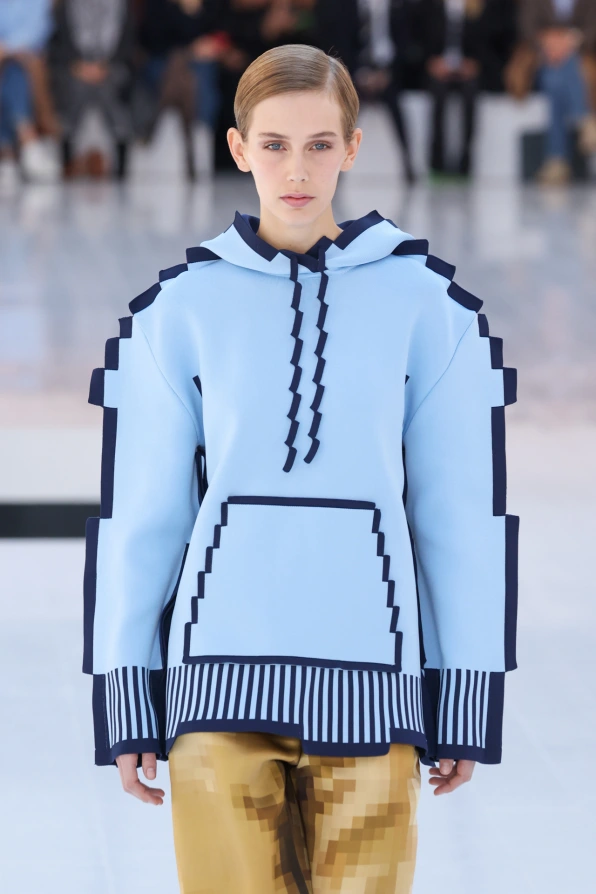These red boots are made for walking
Exploring the ‘cartoonification’ of fashion
MSCHF’s Big Red Boots represent a new tendency in fashion to embrace cartoonish aesthetics, writes Eli Leadham.
March 29, 2023
I am no Anna Wintour, but lately, high fashion has begun to look a lot like Fortnite. Prada’s purses are cartoonishly puffy, Loewe’s eight-bit hoodies look like they spawned out of a video game and just more than a month ago, MSCHF, a New York-based art collective, released Big Red Boots.
Described as “cartoon boots for a cool 3D world,” Big Red Boots have taken the internet by storm, occupying a space between real life and the metaverse. Celebrities like Diplo and Janelle Monae have been wearing them all over Instagram, so they must signify something.
The boots’ virality is partly due to their divisive design, hefty price tag and the fact that no one seems to wear them correctly. Besides the fact that they look like Anna Wintour’s greatest nightmare, Big Red Boots could set the trajectory for the future of technology and fashion.
“Big Red Boots are really not shaped like feet, but they are extremely shaped like boots,” MSCHF said. The boots’ extreme boot-likeness represents the fashions of hyperreality. Hyperreality, a term coined by Jean Baudrillard, captures the inability to distinguish reality from its representation.
MSCHF’s Big Red Boots “takes design cues from a video game,” as Vogue puts it. The giant, impractical, impossible-to-take-off rubber boots were designed more for jumping off rooftops in an imaginary world than for this one. MSCHF forefronts Baudrillard’s concept of a simulacrum in their production of Big Red Boots by essentially producing a copy of a copy. Utilizing the age of hyperreality, the New York art collective produces a rendering of pixelated boots in the physical world that is simply without resemblance to reality — the definition of a simulacrum.

Technology has become really good at representing reality. So rather than implicating it like a cartoon, why can’t we bring the implications of reality to life? That is exactly what MSCHF is doing as part of a growing trend that harkens back to the existentialism of “The Matrix”, where in a world in which nothing feels real, people are opting for cartoonish fashion.
“Cartoonishness is an abstraction that frees us from the constraints of reality,” MSCHF said. “If you kick someone in these boots, they go boing.”
Several brands are beginning to adapt to the trend of “cartoonifying,” their wares. Prada sells puffy handbags that look like clouds, Balenciaga’s XXL stompers look like they were designed in Rhino3D and Loewe released their spring/summer 2023 collection featuring pixelated clothes that resemble something more for a digital avatar than a human.
Loewe also released eerily artificial-looking dresses, skirts and tops for its fall/winter 2023 collections. These garments — void of any creases, wrinkles or drapings — appear too smooth, too static and too real while unreal. It is as if Loewe asked ChatGPT to construct its best copy of a pink tube dress. Loewe’s unreal real designs play with the hyperreal in the same way as the Big Red Boots.
With the recent trend in fashion where the top designers are drawing inspiration from video games and cartoons, is there no longer room for novelty? Today, in an age where the simulation of reality seems more real than reality itself, it appears that we are beginning to lose a sense of originality.
The physical world has long influenced the digital world. Almost everything online is a copy of reality — from usernames to digital wallets. But as the internet evolves, we are now seeing real-world concepts that are metaphors for digital ideas, marking a radical shift in the direction of influence where the physical world draws inspiration from digital copies of itself.
With the rise of cryptocurrency, NFTs and the metaverse, it is common that we digitally own assets like money, land and art. This marks a time in history where digital life is worth more to us than our physical life.
The Big Red Boots have ultimately posed one question — does the distinction between the physical and digital world even matter?
I don’t know the answer, but I know that Baudrillard would have had a field day with the Big Red Boots.














